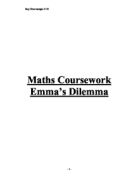5 X 24
Number of letters in James Number of combinations for a four letter word
This totals to 120, so a five letter word with no repeats has 120 different combinations. By applying this rule and using previous results, we can find out the number of combinations for a particular number of letters without writing them all out.
Results
From the results we can already see a pattern. The combination for all different letters divided by two equals that of two letters the same in a word.
Prediction
By looking at the results I have found a pattern. The table below highlights the pattern.
To predict the result for 6 letters:
120 X 6 = 720
To check this:
Let’s take ABCDEF. We know that by putting the A at the front of the word, we are only changing a five letter word. The results for a five letter word with different letters in 120.
120 X 6 = 720
This is the same sum as the pattern that I found. So, we can predict the results for the rest of the numbers by using this rule.
Factorial
The factorial button on a calculator [ ! ] proved very helpful in finding out the rule to Emma’s Dilemma.
Factorial means multiplying itself by all the numbers lower than itself until reaching 1.
e.g. 3! = 3 X 2 X 1 = 6
4! = 4 X 3 X 2 X 1 = 24
By using the factorial rule, the number of combinations is easier to work out. It is simply n! The reason for this is the fact that by doing a four letter word, for example, you are only changing a three letter word. By changing a three letter word and leaving the letter at the front, you are effectively only changing a two letter word and so forth. This is linked to both the pattern that I found above and factorial. The pattern that I saw, by multiplying the result by the next number of letters is actually a longer form of factorial.
By applying the n! rule we can see how it fits in to place.
1! = 1 = 1
2! = 2 X 1 = 2
3! = 3 X 2 X 1 = 6
4! = 4 X 3 X 2 X 1 = 24
Therefore, when there are two letters the same the formula is n!/2 because the number of combinations when there are two letters the same is half that when there all different letters.
Three Letters the Same
Let’s look at different words with three of the same letter.
By using these three results we can start to see the main rule.
Results
By looking at the results I can see that the results for three letters the same is a third of the results for a word with two letters the same, in the same row. This means that to get the result for 3 letters the same in a word:
( n ! / 2 ) / 3 simplified n!/6 because 2 X 3 = 6
I predict that for four letters the same the formula would be:
( ( n ! / 2) / 3 ) / 4 simplified n!/24 because 2 X 3 X 4 = 24
The Formula
There is in fact a link between the formulas shown above where you divide n! by 2, 6, 24 e.t.c. and the factorial numbers itself. By looking at the numbers we can see that 2, 6, 24 is in fact 2!, 3!, 4! and so on.
( n ! / 2 ) / 3 = n!/6 = n!/2!
( ( n ! / 2) / 3 ) / 4 = n!/24 = n!/3!
Let’s put this in a table:
Notice that the 2! or 3! that n! is divided by equates to the number of letters the same in each word. By using the information on this page we can find a general formula for the ‘dilemma’.
N!
L!
Where…
N is the number of letters in the word;
L is the number of letters the same.
This formula is a general rule for all combinations containing any number of letters with a number of letters the same (excluding combination of letters that have more than one letter repeated, i.e. AABB cannot use this formula).






